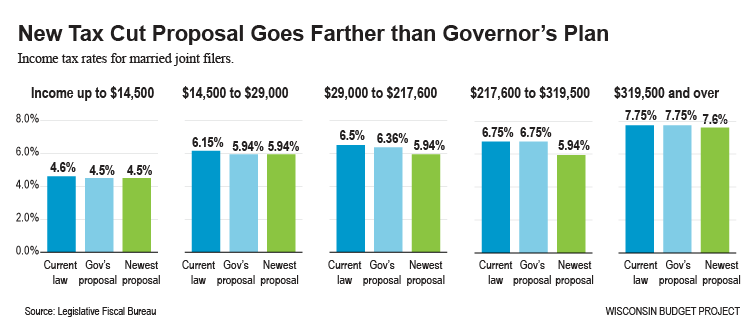We retired Tax Justice Blog in April 2017. For new content on issues related to tax justice, go to www.justtaxesblog.org

Wednesday, June 5, 2013 Update: The Wisconsin legislature’s Joint Finance Committee approved a budget early this morning that included an income tax cut that reduced income tax rates from 4.6%, 6.15%, 6.5%, 6.75%, and 7.75% to 4.4%, 5.84%, 6.27%, and 7.65%. The legislation also reduced the number of tax brackets from five to four. This plan stops short of Rep. Kooyenga’s plan plan described below, but is more costly than Governor Walker’s $340 million initial proposal. According to the Legislative Fiscal Bureau (PDF) these permanent tax cuts cost $632.5 million over two years and the distribution is again skewed to benefit the wealthiest Wisconsinites. Current reporting suggests this plan will pass the full legislature.
This week Wisconsin Representative Dale Kooyenga, an accountant who’s taking a lead roleon tax policy, released his plan to reform the state’s tax code. In a proposal that would more than double the tax cuts proposed by Gov. Scott Walker, Kooyenga seeks to reduce personal income tax rates and cut the number of income tax brackets from five to three. The latter would, as one report put it, put middle income earners like a secretary at a law firm in the same tax bracket as the high-earning lawyers. Kooyenga touts simplifying the forms taxpayers file and eliminating nearly 20 tax credits.
Earlier this year, Governor Scott Walker proposed his own income tax cut ,which was slammed for mostly benefiting the wealthy (in large part because an Institute on Taxation and Economic Policy (ITEP) analysis showed that it was tilted that way). The Governor’s proposed income tax rate cuts were expected to cost the state $343 million over two years; Representative Kooyenga’s would cost $760 million in the upcoming budget and $914 million in the 2015 budget.
And it’s not just costly, it’s regressive. As the lawmaker himself concedes, “[i]t is nearly impossible to create a tax reform or tax cut that is not going to disproportionately lower taxes for upper-middle-class and rich taxpayers,” and a new ITEP analysis of Kooyenga’s plan shows his is no different. ITEP ran the numbers for the Wisconsin Budget Project (WBP) the impact of the Kooyenga income tax plan was shown to be even more skewed to the wealthy that Governor Walker’s, as WBP writes:
Here is how the tax cut would be distributed among income groups:
– The top 5% of earners alone, a group with an average income of $392,000, would receive more than 1/3 of the benefit of the income tax cuts.
– The top 20% of earners, a group with an average income of $183,000, would receive more than 2/3 of the benefit.
– The bottom 60% of earners – those making $60,000 a year or less – would only receive 11% of the benefit of the income tax cuts.
– The 20% of the Wisconsinites with the lowest incomes would receive just two cents out of every $100 in individual income tax cuts under this proposal.
WBP says that the Kooyenga tax plan’s expansion of Governor Walker’s proposal is a “bad idea made worse,” and they are right. 